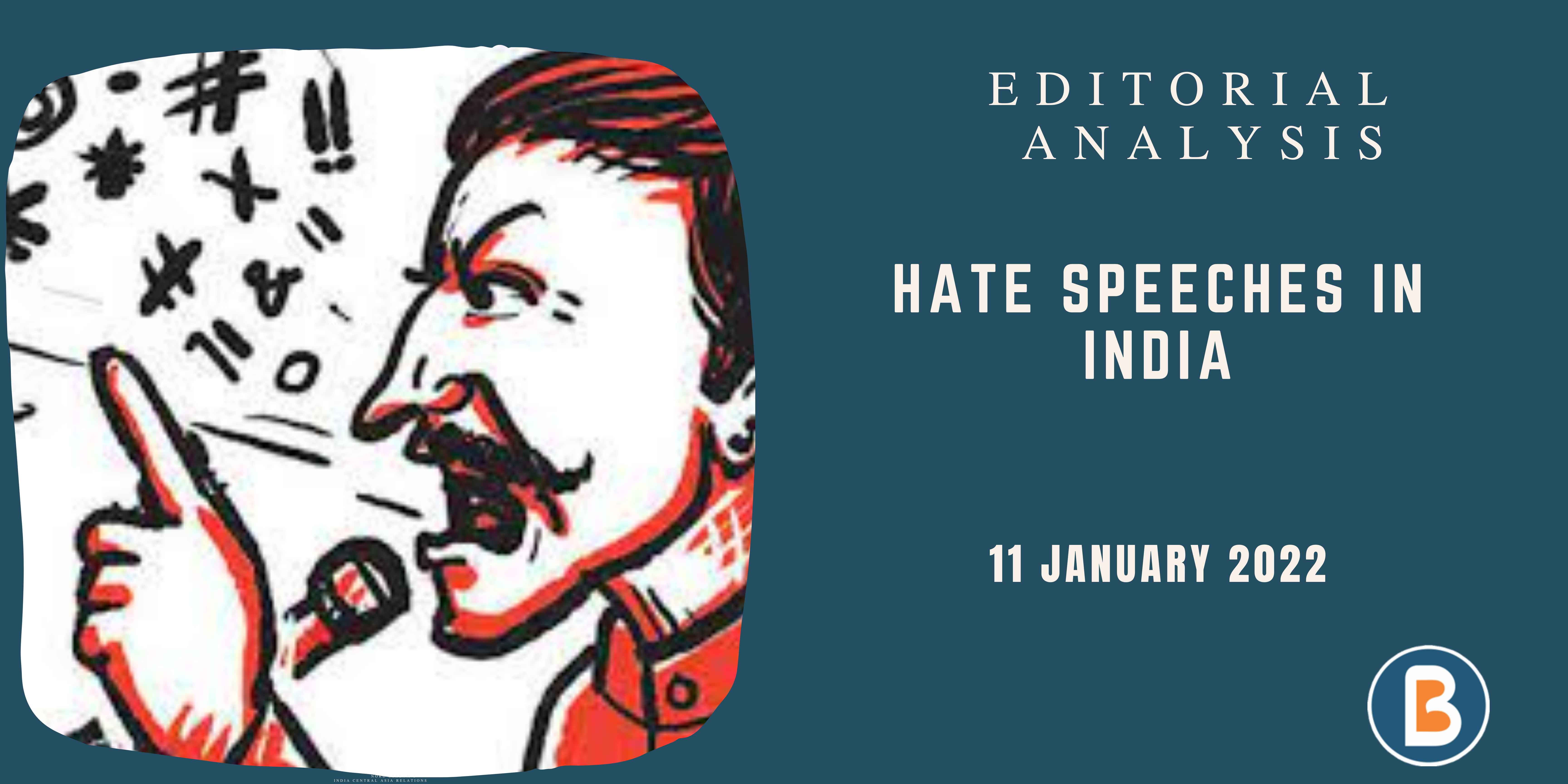HATE SPEECHES IN INDIA
About The ‘Hate Speeches’:
- It refers to comments that are intended to incite hatred toward a specific group, which could be a community, religion, or race.
- This speech may or may not be meaningful, but it will almost certainly lead to bloodshed.
- Hate speech is defined as language that denigrates, degrades, threatens, or targets an individual based on their identity or other characteristics, according to a guidebook released by the Bureau of Police Research and Development for investigating agencies on cyber harassment cases (such as sexual orientation or disability or religion etc.).
- Hate speech is defined as an incitement to hatred directed principally towards a group of people based on race, ethnicity, gender, sexual orientation, religious belief, or other factors, according to the Law Commission of India’s 267th Report.
- The context of a communication plays a crucial role in determining whether it is a hate speech or not.
- One of the most difficult difficulties is to avoid using the ideas of autonomy and free speech in ways that are harmful to any part of society.
- Where hate speech becomes an exception to Article 19(1) (a), free expression is required to promote a diversity of viewpoints (Freedom of Speech and Expression).
Hate Speech’s Major Causes:
- Feeling of Superiority: People have prejudices embedded in their thoughts that lead them to believe that a certain class or group of people is inferior to them and so cannot have the same rights as them.
- Stubbornness to a Specific Ideology: Stubbornness to a Specific Ideology without regard for the right to peaceful coexistence gives fuel to the flames of hate speech.
Hate Speech’s Legal Status:
According to the Indian Penal Code:
- Acts that promote animosity and hostility between two communities are punishable under sections 153A and 153B of the IPC.
- Acts that deliberately or maliciously insult the religious sensibilities of a group of people are punishable under Section 295A of the IPC.
- Sections 505(1) and 505(2) make it illegal to publish or circulate anything that may incite animosity or hostility amongst various communities.
- Section 8 of the Representation of People’s Act, 1951 (RPA) prohibits a person convicted of illegally exercising their right to freedom of speech from contesting an election.
- Sections 123(3A) and 125 of the RPA prohibit the promotion of hatred based on race, religion, community, caste, or language in connection with elections and classify it as a kind of corrupt electoral conduct.
Changes in IPC Suggestion:
- The Viswanathan Committee proposed amending the Indian Penal Code (IPC) to include Sections 153 C (b) and 505 A for inciting to commit an offence on the basis of religion, race, caste or community, sex, gender identity, sexual orientation, place of birth, domicile, language, disability, or tribe.
- It advocated a sentence of up to two years in prison and a fine of Rs. 5,000.
- The Bezbaruah Committee proposed amending Section 153 C of the Indian Penal Code (promoting or attempting to promote acts prejudicial to human dignity), which is punishable by five years in prison and a fine or both, and Section 509 A of the Indian Penal Code (using words, gestures, or acts to insult members of a particular race), which is punishable by three years in prison and a fine or both.
Some Recent Hate Speech Cases:
- The Supreme Court (SC) recently held that “historical truths must be depicted without in any way disclosing or encouraging hatred or enmity between different classes or communities” in the context of discussing the limits of free speech and what may be considered hate speech.
Union of India v. Shreya Singhal:
- There were concerns raised about Section 66A of the Information Technology Act of 2000, which dealt with the fundamental right to free speech and expression guaranteed by Article 19(1)(a) of the Constitution, in which the Supreme Court distinguished between discussion, advocacy, and incitement, concluding that the first two were the essence of Article 19(1)(a) of the Constitution (1).
- In Arup Bhuyan vs. State of Assam, the Court concluded that a single act could not be punished unless the perpetrator used violence or incited others to use violence.
- In S. Rangarajan Etc vs. P. Jagjivan Ram, the Court stated that freedom of expression cannot be suppressed unless the situation created is dangerous to the community/public interest, and that this risk must not be remote, speculative, or improbable. With the expression in question, there should be a close and direct link.
Next Steps:
- Education is the most effective means of reducing animosity. Our educational system has a significant role in creating and comprehending compassion for others.
- The fight against hate speech cannot be conducted in isolation. It should be considered on a larger scale, such as in the UN. This threat should be addressed by all responsible governments, regional organisations, and other international and regional actors.
- Hate speech cases can be dealt with through Alternative Dispute Resolution, which suggests a change away from the lengthy judicial procedures and toward the settlement of disputes between parties by negotiation, mediation, arbitration, and/or conciliation.
- Public authorities must also be held accountable for failing to fulfill their duty of care and for failing to comply with this court’s orders by failing to take action to prevent vigilante groups from inciting communal strife and spreading hate against citizens of the country, as well as taking the law into their own hands.
Source: THE HINDU.




